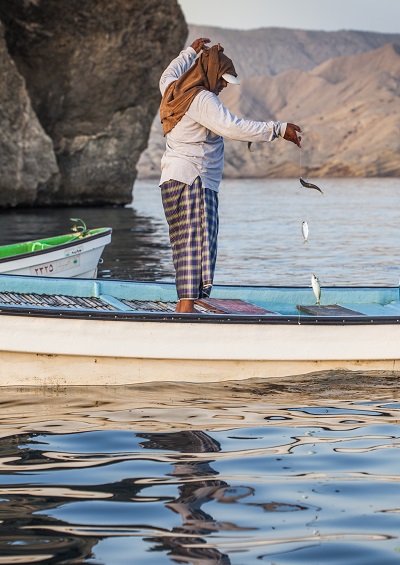Tourism Takes Over in Oman
The rise of beachfront resorts blocks local access to the sea that fed generations of Omanis.
April 30, 2016

Basel Almisshal is an award-winning architect, artist and professional photographer who currently runs his own design studio in the Middle East.
He is the founder of the “Capture the Spirit of Ramadan” International Photography Competition, an initiative aimed at using the art of photography to remove misconceptions about cultures and religion.
For as long as anyone can remember, fishing, particularly for tuna and hammour – the local name for grouper – was the lifeblood of Qantab, a modest village just outside Oman’s capital, Muscat.
But that’s changing. Villagers such as Juma Al Hasani, 50, whose family has lived in Qantab for several generations, still earn some money from selling fish to visitors or for using their boats to carry tourists on the short trip to the nearby yacht club or the Shangri-La Barr Al Jissah, a five-star resort.
But most of them also have regular day jobs in the city, or like Juma, a former government worker with a wife and five children, have retired.
And now, the two-kilometer road to Qantab beach is blocked, and fences have appeared around the beach area. Construction of a hotel-resort will start soon.
The Ministry of Tourism has decided developing the beach would attract more visitors and make more money. It seems likely that most or all of the beach will soon only be open to hotel guests.
Text and photographs by Basel Almisshal
 Basel Almisshal is an award-winning architect, artist and professional photographer who currently runs his own design studio in the Middle East. He is the founder of the “Capture the Spirit of Ramadan” International Photography Competition, an initiative aimed at using the art of photography to remove misconceptions about cultures and religion.
Basel Almisshal is an award-winning architect, artist and professional photographer who currently runs his own design studio in the Middle East. He is the founder of the “Capture the Spirit of Ramadan” International Photography Competition, an initiative aimed at using the art of photography to remove misconceptions about cultures and religion.The Other Hundred is a unique photo-book project (order here) aimed as a counterpoint to the Forbes 100 and other media rich lists by telling the stories of people around the world who are not rich but who deserve to be celebrated.
Its 100 photo-stories move beyond the stereotypes and cliches that fill so much of the world’s media to explore the lives of people whose aspirations and achievements are at least as noteworthy as any member of the world’s richest 1,000.
 Selected from 11,000 images shot in 158 countries and submitted by nearly 1,500 photographers, The Other Hundred celebrates those who will never find themselves on the world’s rich lists or celebrity websites.
Selected from 11,000 images shot in 158 countries and submitted by nearly 1,500 photographers, The Other Hundred celebrates those who will never find themselves on the world’s rich lists or celebrity websites.



